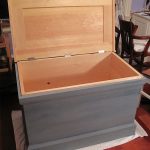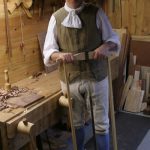We may receive a commission when you use our affiliate links. However, this does not impact our recommendations.
 As I was finishing up the exterior of my “Anarchist’s Tool Chest,” I ran into a little problem while fitting the three hinges (which are 1-1/2″ x 2″ solid brass butt hinges from Horton Brasses, with a brushed nickel finish – love ’em).
As I was finishing up the exterior of my “Anarchist’s Tool Chest,” I ran into a little problem while fitting the three hinges (which are 1-1/2″ x 2″ solid brass butt hinges from Horton Brasses, with a brushed nickel finish – love ’em).
Obviously, the lid and dust seal (the upper skirt) had to be in place before I could install the hinges – because I had to make sure those fit together well before I could place the hardware. But with the dust seal in place, there’s only a 1/2″ from it to the top of the case – and that was not enough room for my trusty Tite-Mark mini – a tool that for 99.9  percent of my gauge needs is the cat’s pajamas.
percent of my gauge needs is the cat’s pajamas.
As you can see in the photo at right, I can’t register the brass face of the Tite-Mark against the outside of the chest and mark the edge of my hinge mortise. (You’ll no doubt also note that my mortise is already cut in the picture and there’s a coat of paint applied…because I forgot to stop and take shots during the install. Oops.).
Were I desperate, I suppose I could have reset the gauge to register off the face of the dust seal…but that would be an wide-open invitation to error. (The gauge should, of course, be set to the width of the hinge leaf and – assuming you’re using well-machined hinges that are identical in size – you want to leave it set until all six mortises are marked.) But I’d have used a combination square and marking knife before I went that crazy route.
 But luckily, I’d taken the chest over to Christopher Schwarz’s shop to paint it (I didn’t want to fling paint around in my study/shop…but was perfectly willing to fling it around in his shop!), and he happened to have just the thing to solve the problem – a 4″ Hamilton marking gauge, which has a very low profile – just 3/8″ below the blade.
But luckily, I’d taken the chest over to Christopher Schwarz’s shop to paint it (I didn’t want to fling paint around in my study/shop…but was perfectly willing to fling it around in his shop!), and he happened to have just the thing to solve the problem – a 4″ Hamilton marking gauge, which has a very low profile – just 3/8″ below the blade.
So while I swear by the Tite-Mark (I have two minis and one full-size version), well, I think I’m going to branch out and buy a small Hamilton gauge (a well-made and handsome tool). While I may not need a low-profile gauge for most of my work, I am going to build a smaller version of the same tool chest (or a similar one) soon…because my full-sized chest is now at home, on the second floor of my house. And it was not fun getting it up the stairs. Once I get the interior done and the tools inside, that sucker isn’t moving.
— Megan Fitzpatrick
@1snugthejoiner
p.s. Whether or not you want to build a traditional tool chest, I can’t recommend Christopher Schwarz’s “The Anarchist’s Tool Chest” highly enough. Yes, it has step-by-step instruction on building the chest, but of more interest to me is the philosophy behind the build, and the discussion of the small list of tools that should be in every hand-tool shop. (But I have more than are on his list. I’m a poor student – or a very good one; one of the lines in the book states: “Disobey me.”)
Here are some supplies and tools we find essential in our everyday work around the shop. We may receive a commission from sales referred by our links; however, we have carefully selected these products for their usefulness and quality.








Now Megan… Christopher told you that if it doesn’t fit in the chest you don’t need the tool. I agree with your comment’s on his wonderful book. I relate to the philosophy and think we would all be wiser, if not happier, if we bought fewer (but quality) tools and mastered the use of the ones we have.
No cost simple solutions exist:
1. Cut a piece of scrap to fill the gap and use your favorite marking gauge.
2. Use a sliding combination square or a depth gauge to layout the hinge with a sharp pencil.
3. Use a compass or a divider like you did on your dovetail layout. I think I’d put a piece of scrap on the edge so the point is dead on. All rulers have indentions for the marks and are easy to use for setting calipers.
4. I’ve even used needle nose visegrips on a 12″ ruler in the field with limited tools.
There are many more, but this ought to do.
One marking gauge isn’t enough. I have seven full sized gauges, three mortising gauges, a Lee Valley mini, a user-made mini, and a cutting gauge made by my friend Jon Fox. I use all of them. I keep some of them set to specific dimensions. One of my mortising gauges (modified by me) has two nails in it, set to exactly the width of my favorite mortise chisel, roughly 1/4″.
Another way to deal with it is to build another “fence” for your gauge. Run a piece of scrap through the planer to make sure both sides are parallel and drill a hole for the shaft at 90 degrees. You can modify this fence for any size you need.
A couple of options for you Megan: a cute little marking gauge made by Bridge City TooL Works and known as the MG-5,
will let you mark on a ledge as small as 1/2″. And so will the new Veritas Stainless Steel Marking Gauge with it’s eccentric shaft wich has a clearance of exactly 1/2″ on the short side. I’m lucky enough to own both of them and also the Hamilton gauge and I beleive they are outstanding tools and a delight to use.
Another area where a Tite-Mark style marking gauge design falls short is in scribing lines for half-blind dovetails at drawer fronts. I sacrificed one of my gauges at a disc sander so it would do the job. Worked fine until I discovered a Hamilton gauge. Snapped it up immediately.
I’ve always used hot-melt glue or double-sided tape to surface-position my hinges, and then used the hinge leaves as the gauges for my mortises. At least the marking knife used to define the mortises was traditional.
I bought a 4″ Hamilton at WIA 2011. It’s my go-to gauge for most projects.
The simplest solution is to place one of the hinges (Inverted) and knife it’s perimeter.
Another method would be to “hone” a countersunk screw head – so it’s edges are sharp – and set it into a small block of wood (The fence)to the correct marking distance from the face edge. It’s infinitely adjustable within the reach (Length) of the screw being used.
Both are incredibly inexpensive and accurate methods/tools.
I’ve got a 6″ Hamilton gauge and its great. Well made, looks nice, solid grip and the thumb nail grind on the blade works with the grain, perpendicular, diagonal, upside down and underwater. It’s the best wood bodied gauge that I’ve used. I have not used a Tite-Mark though. I found the Hamilton gauge and never looked back.
Could you have used a combination square with the ruler set to the width of the hinge and scribed a line along the base of the ruler?
The other option — and I’ve considered it — is to grind, sand or file a flat on a Tite-Mark gauge to allow it to do this close-quarters work.
You first.